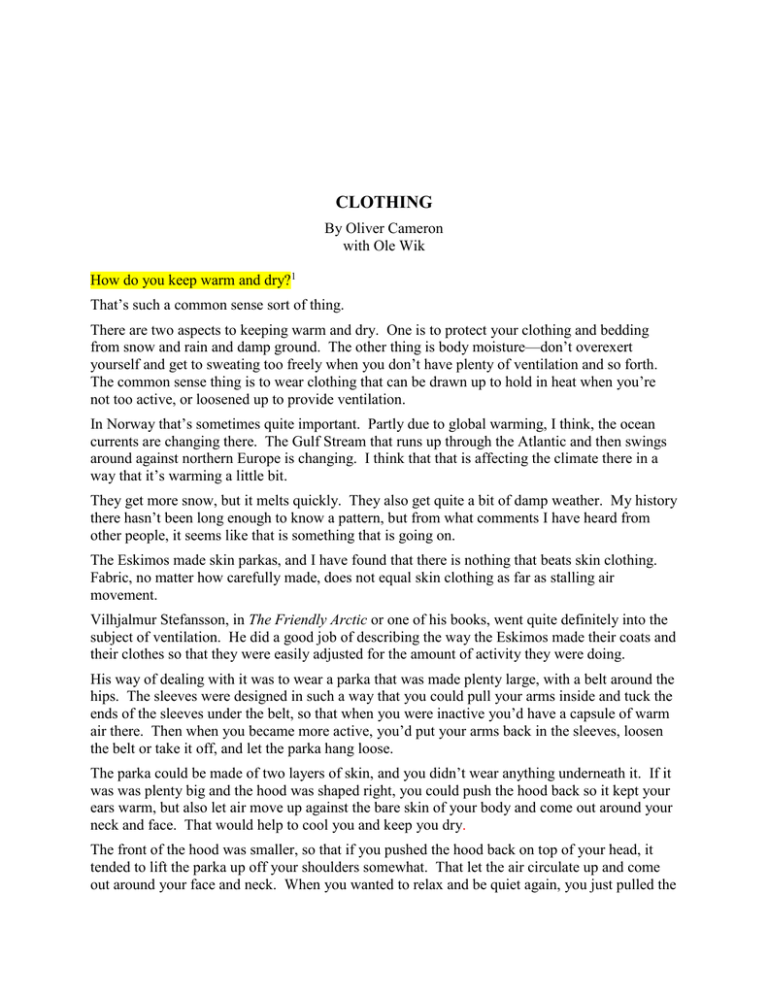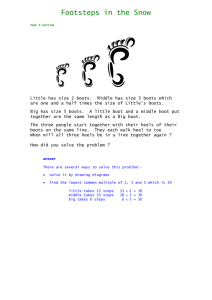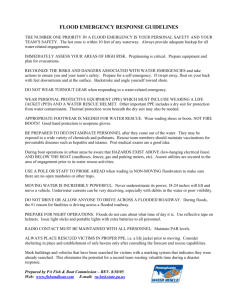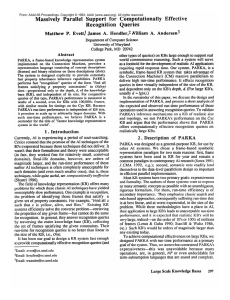clothing - Oliver Cameron
advertisement

CLOTHING By Oliver Cameron with Ole Wik How do you keep warm and dry?1 That’s such a common sense sort of thing. There are two aspects to keeping warm and dry. One is to protect your clothing and bedding from snow and rain and damp ground. The other thing is body moisture—don’t overexert yourself and get to sweating too freely when you don’t have plenty of ventilation and so forth. The common sense thing is to wear clothing that can be drawn up to hold in heat when you’re not too active, or loosened up to provide ventilation. In Norway that’s sometimes quite important. Partly due to global warming, I think, the ocean currents are changing there. The Gulf Stream that runs up through the Atlantic and then swings around against northern Europe is changing. I think that that is affecting the climate there in a way that it’s warming a little bit. They get more snow, but it melts quickly. They also get quite a bit of damp weather. My history there hasn’t been long enough to know a pattern, but from what comments I have heard from other people, it seems like that is something that is going on. The Eskimos made skin parkas, and I have found that there is nothing that beats skin clothing. Fabric, no matter how carefully made, does not equal skin clothing as far as stalling air movement. Vilhjalmur Stefansson, in The Friendly Arctic or one of his books, went quite definitely into the subject of ventilation. He did a good job of describing the way the Eskimos made their coats and their clothes so that they were easily adjusted for the amount of activity they were doing. His way of dealing with it was to wear a parka that was made plenty large, with a belt around the hips. The sleeves were designed in such a way that you could pull your arms inside and tuck the ends of the sleeves under the belt, so that when you were inactive you’d have a capsule of warm air there. Then when you became more active, you’d put your arms back in the sleeves, loosen the belt or take it off, and let the parka hang loose. The parka could be made of two layers of skin, and you didn’t wear anything underneath it. If it was was plenty big and the hood was shaped right, you could push the hood back so it kept your ears warm, but also let air move up against the bare skin of your body and come out around your neck and face. That would help to cool you and keep you dry. The front of the hood was smaller, so that if you pushed the hood back on top of your head, it tended to lift the parka up off your shoulders somewhat. That let the air circulate up and come out around your face and neck. When you wanted to relax and be quiet again, you just pulled the hood ahead and let the parka settle back down on your shoulders. Your head would be back in the socket of the hood, with the jacket tight on your shoulders. Then you’d have a very warm piece of equipment. Vilhjalmur Stefansson. Image: http://undnews.areavoices.com/2013/10/31/public-invited-to-und-canadianconsulate-general-symposium-on-canadian-arctic-on-nov-5/ I have used that, though not in the full way that he described it. I bought some fawn skins one time and made a skin parka. I had some help with the design. Even when it was quite cold, I would wear that parka when I was riding on the sled or not exerting myself much. It had a cloth cover over it, with a cord that I could pull to bring the ruff up around my face. The hood was designed so that I could loosen that cord and push the ruff back on top of my head and let considerable air go through. When I was working hard, I couldn’t figure out any way to wear it without working up a sweat. So, when I got to the place where I was cutting firewood, I would pull it off down to my bare skin, even though the weather was quite cool. I’d work like a demon getting the wood cut and ready to load, and then I’d put the parka back on. When you have a head of steam up and you’re working hard and you and your body is hot, it takes a while for you to cool off, even in the cold. Of course when it’s really cold, there usually isn’t any wind. I don’t know if it would be of any value to know about that, but I guess it wouldn’t hurt to mention it. I was fortunate to be friendly with people who understood those kinds of things and knew how to cut the hides to accomplish those purposes. Where did you buy the fawn skins? I think they came from a reindeer herd up near Point Hope someplace. 2 When was that? That would have been in the late 1950s or early 1960s. I bought the skins about the time that I moved up to Ambler. I had it partly made before I went up the river, and finished it after I got up to Ambler. Who helped you? There were two women. One was Maude Cleveland, and the other was Dora Johnson. Mark Cleveland once mentioned that the villagers no longer wore caribou garments because they associated them with poverty. I was the first person up the river that had an Eddie Bauer down parka. I noticed that it wasn’t too long until a lot of the men were wearing down parkas, and some of the women too. Before that they’d been wearing muskrat parkas and caribou skins. Caribou skins throw a lot of hairs, so they’re not so popular for something takes a lot of work to make. I have used home-tanned caribou skins, with all the hair off, to make a vest. It has a number of pockets on it, and is really handy. I also have a whole suit of clothes with the hair on—a fairly long coat and a pair of pants. Sometimes I don’t want a whole outfit like that. The Eskimos used marmot and muskrat fur instead. Mark Cleveland had a jacket made from lynx skins. He said that it was very warm and very light. That was about the time when the men quit going over onto the Noatak in the spring to hunt caribou, and bring back fawn skins and meat with pack dogs. Another reason they were going over there was to trap marmots. I understand it takes 60 muskrats to make a parka. That sounds about right, but needs qualification. I think that 60 would make a man’s jacket and part of a woman’s parka. The woman’s parka takes more skins. They used the bellies for women’s parkas, and the backs for men’s. How did you keep your feet warm? I think that anybody who goes out like that is going to have that figured out beforehand. I was trying to think of the name of those boots that almost everybody used, with felt liners made something like a shoepack. Sorels. But I never had a pair. Sorel shoepacks. Image source: http://the-coveted.com/blog/wp-content/uploads/2010/12/sorel_caribou.jpg 3 For real cold weather I made mukluks, and when it was a little warmer, I bought Tingley boots. They were made of light rubber, and had a folding front that kind of buttoned over. Tingley Overboots. Image: http://www.amazon.com/Overboot-Plain-Men-9-5-11Black/dp/B0078QZ7ZC/ref=sr_1_35?ie=UTF8&qid=1386238872&sr=835&keywords=tingley+overboots When I first went to Alaska, the Army was clearing out Ladd Field. There was a lot of GI clothing that was on sale very cheaply, and I bought quite a few pairs of those white felt boots. I’d wear a pair of white socks and those felt boots in the big Tingley overshoes, as well as an insole. Military surplus felt boot liner. Image: http://www.mollymacpack.com/muklukpics.html If I was going to be out for a long time, really walking or snowshoeing, I would take a plastic sack and pull it over the light sock. That wasn’t the most comfortable thing, but it would confine the moisture to the innermost sock and keep the rest of my footgear dry. Why wasn’t it comfortable? Your feet got too wet inside that plastic. 4 But it did keep your feet warm. I used to carry one or two extra pairs of socks. I would take my footgear off once in a while and wring those socks out. I’d put on a dry pair of socks on, and stick the wet ones under the lashing of my sled in such a way that they could dry out a little bit. One other thing. When you come in at night, you take your felt liners out of your boots and hang them up above your stove, independently. Did you ever wear bunny boots? I never had any. “Bunny Boots is the widely-used nickname for the Extreme Cold Vapor Barrier Boots (Type II) used by the United States armed forces.” http://en.wikipedia.org/wiki/Bunny_boots In the springtime, did you wear the kind of mukluks that had ugruk2 soles and sealskin tops? Yes. Those waterproof sealskin boots were real good in the springtime, and in the winter too if you figured you might be breaking through the overflow. They were almost always made with ugruk bottoms, which are slippery, so quite often I would have them made with the inside of the skin out. Then I could roughen up the bottom with my ichuun. Ichuun (skin scraper) made by Oliver. Image: Molly Rettig, Cold Climate Housing Research Center, University of Alaska, Fairbanks If you’re wearing that kind of footgear and the weather's cold, and you dress your feet inside the house when your footgear is warm, it melts some snow and collects some ice on the bottom 5 when you step out onto the snow. Then everything is slippery, and you’ve got an accident waiting to happen. So whenever I was wearing that kind of footgear, I kept my mukluks hanging outside. I’d go to the door and bring them in, put them on, and get out again real quick. I had a pair of those made when I was working at Wales. They were amazingly light. I wore them at spring camp, and could walk in the slush on a lake, or go anywhere else. But when they dried out, they shrank so much that I couldn’t wear them again. As they’re drying, you need to pull them down over a shovel handle or some other kind of a stick. An axe handle works well. You start working it back and forth to stretch out the leather, and you keep it stretched while it’s drying. I’ve had several pair of those. One pair was evidently made by somebody who wasn’t such a careful craftsman. I’m not sure what kind of thread she used, but it was the wrong kind, maybe nylon.3 The stitches around the toe and sides, and up and down the heel, were open enough that the wind would blow through and get in there. That was one of the first pairs I had, and I wasn’t yet familiar with all those different kinds of materials. When you use sinew and a small needle and you pull the sinew into the stitch, the sinew swells up when the leather gets wet. That helps maintain a tight seal. It was amazing to me how much difference that makes. It doesn’t look as if that much air could get in there, but you sure could feel it after a bit. That was before I had started wearing and making skin socks. I was just using wool socks. How did you make skin socks? It’s not really all that complicated. You usually make them out of leg skins from a caribou, because the hair is shorter and more permanent on the legs. You wear them with the hair side in. The first time I made some, I made the pattern after a pair of sheepskin socks I had. You have a sole that’s a little bigger than the bottom of your foot with your socks on. Then you have a toe piece that sews onto that, with the edges gathered a bit over your toe and around to the sole. Then you have another, longer piece of caribou skin. Sometimes you trim the hair off that a little shorter. It wraps around the heel and comes together on the front of the foot, big enough that you can slide your foot inside of it. The sides of that come right down to the sole and across your instep. The toe piece comes clear across your foot, and the back piece is shaped off there so that it fits together and sews onto the toe piece. It’s not likely that anybody would be making those on their own nowadays. People who have access to caribou might possibly want to, but I think that everybody would be using bunny boots or those shoepack things. What about hand gear? I have a certain pattern that I use in making my overmitts. We call them sled mitts. They hang over my neck, and have another cord across my chest. You can pull your hands out, throw those mitts behind you, and twist them a little bit so they stay there. I make a smaller pair with less fur on them, less bulky, that fit inside. Sometimes, if the weather is not too severe, I’ll wear a lightweight leather glove inside my overmitts. Even though leather gloves are sometimes a little damp, they break the wind, and it’s better than trying to untangle harness and work with frozen snaps and so forth with your bare 6 hands. Eventually I got my harnesses worked out so that they had no metal on them at all. I used wooden toggles. I like my overmitts with long caribou chair inside. I’ve also made them with wolf skin and dog skin. It’s nice to have long fur inside so that there is not a lot of air moving when you have your hand down in there. I would usually have them big enough that I could wear pigskin gloves that fit real snug on my hand. They were like dress gloves. They went inside of everything else. When the weather was really cold, I found that those leather gloves seemed to cut off the circulation to some extent, so I didn’t use them. But when it was windy and not too cold, they were handy. And if you stop to make tea, you can get out of the wind and it doesn’t take too much on your hands to cuddle a cup of tea and keep your hands a little warm. When I talk about a cup of tea, I don’t mean a teacup. I mean something more the size of a pint, or getting up there anyway. Did you use overpants? No. I prefer to wear a fairly long parka, and to heck with the pants. They’re hard to get on and off, they’re bulky, and you get sweaty in there. I did have a pair of bear hide overpants at one time, but didn’t use them much. Eventually I cut them up and made leggings out of them. Oliver with bear hide overpants, caribou parka and fur overmitts. Note the deep hood. Image source: ? I usually use make leggings something like hip boots, except that they go from the sole of your foot all the way up. I make mukluks that tie off just below my knee. I wear leggings that extend 7 down a little bit below them. They have a channel in them so I can tie them off too, at about the same place. They have another tie around the top that is designed in such a way that I can pull the leggings up around my thighs under my parka. Or, I can push them down like a pair of hip boots, pull the tops back up a little, and tie them just above the calf. What did you make them out of? Any kind of skin that I had. You can make them out of caribou leg skins, but there again you’ve got the problem that they don’t last as long. The hair breaks off. I’ve used dog skin quite a bit. I’m not at all sentimental about dogs. If it’s time to get rid of one of them, I don’t mind skinning it and using its skin. I don’t especially like the smell of dead dogs, but that goes away after a bit. The skins make good mittens4 and leggings and inner socks. I have a pair of leggings that I made out of a pair of jeans. Well, not jeans—they were more like dress pants, with larger legs. I fastened leggings onto them just below the knees. They each have a string on the top that I can just wrap around my belt a couple of times to keep the leggings up. Then, when I start walking or snowshoeing and get warm, I can just roll the leggings down and tie them with the drawstring in the top, just below my knees. That way I don’t have to fool around taking them off and finding some way to carry them. And when I stop or otherwise start to get cool again, I can very quickly pull them back up. The leggings cover the area from my high-top mukluks to my hips, and don’t extend very much below the knee. If I’m getting hot I not only roll the leggings down and tie them below the knee, but I’ll roll the mukluks down too. Of course that assumes I’m snowshoeing or walking on a hard trail, not stepping down into a foot of soft snow. What about headgear? I’ve had beaver and cold weather caps. I had one I really liked made out of marten skins. It was light, not too bulky, and quite warm. It had flaps that came down and could fasten under my chin. I could also put the flaps up and fasten them on top of the cap to let my neck and the sides of my face be exposed for cooling. How about scarves? People use scarves and things like that to cover their faces and mouths, and breathe inside of them. I found that they get wet and freeze up, and you have to shift them around and all that monkey business. I prefer to have a good hood. If your ruff is made right, it’s designed so that you can pull it out in front of you and have a little pocket of warm air that you’re breathing all the time. Did you ever have a beard? Stefansson insisted that his men shaved, because otherwise they’d have trouble with ice accumulations and frostbite. Yeah. I wasn’t ordinarily out for the long, long periods that he was, all day like that. I would be out long enough to where the frost would form on my moustache and beard, but it never really froze up right next to my skin. 8 Of course when I came in the house I’d be sitting there pulling hunks of ice off my beard and moustache as the frost started to soften. Most of that moisture was from my breath. Is there anything else you’d like to say about winter clothing? I can’t think of anything right now. What about clothes for summer, for boating and so on? In that kind of a situation I like wool sweaters and a windbreaker or a raincoat. Standing in the back of a boat, steering a motor, not moving around much, gripping that extension arm with your hand, you start getting chilly and more chilly, and pretty quick your hands are getting numb. Then it’s time to go ashore and build a fire. One fall, when Kalle was small, we went down to our iglu near Kantners’ to get some gear. We went down into the face of a stiff north wind. The next day we came back against a nasty east wind, with sleet. I remember that I had to pull the hood of my heavy raincoat sideways far enough to cover the side of my face that was toward the wind, in order to keep the gritty ice crystals out of at least one eye. Poor Kalle huddled under sleeping bags in the front of the boat, both ways. I have similar memories. We were far enough in from the coast that there was a lot of unsettled wind affecting the area around Ambler. The wind up there could sure swing around in a short time. Yeah, and especially in the fall time. I used to say that the four winds were battling for the control of the sky. When I built that big boat, I had wide gunwales for most of the length, six inches wide I guess. I had a 2x4 on edge that raised the inside, making another wall around the inside edge of that gunwale. I had straps fastened to that 2x4 so that I could put willows in, bend them over, and fasten them together at the top. I had a canvas cover made to fit that, with eyelets along the edges that would be fastened over staples and secured with wooden pins. Oliver and family with canvas canopy on travel boat. Image: Cameron family slides That covering was just high enough that I could stand behind it and look over it. It was one tremendous help when I was in that kind of a situation, facing the wind in bad weather. What about footgear for boating? 9 I usually wore hip boots, because I didn’t like to run my boat up onto the bank or nose it in too much. There was a time when I could qaqisak4 the boat, but not usually, so I couldn’t just jump off the boat onto the dry ground. I’d usually pull the boat up parallel to the bank so that I could step out of the boat into the water there. Hip boots were plenty tall enough. I used hip boots a lot when I worked as a boat ranger in Glacier Bay. One of my favorite tricks was to fold them down when we were working for some time on shore, and then forget to fold them back up before wading into the water to get back into our high-sided boat. I don’t recall doing that, but I’ve worked ashore and then pulled my boots up and dumped a lot of stems and leaves and stuff right down inside them. Oh boy. What about eye protection? I experimented with several types. I had a pair of colored glasses that were very dark. They kept my eyes comfortable, so I’d use them if my eyes were sore. They had wings on the stems that cut off a lot of the light from the side—a little more than I liked—but light could still come in underneath them and around the nose. That was for summertime, for glare off the water. When you’re running a boat, you have to watch for something floating ahead of you. Did they have polarized lenses? Yes. Those really dark glasses were not, but when the weather was not so bad, I did use polarized glasses. I don’t like plastic glasses. I usually had real glass lenses. I once had some un-colored polarized glasses. They cut the glare off the water, and were quite useful for grayling fishing. You could see the fish very easily and drop your lure right in front of them. What about belts? I have a woolen belt that Sasha made on a little loom. I asked her to make it real long for me. It was 1-1/4” wide or something like that. I had it made with the blue of the sky, the brown of the earth, and the green of the water. I still have it, and I still use it when I’m wearing my parka. Sasha weaving a band on her backstrap loom. Loom and photo by Ole Wik 10 I have one end doubled back and sewn so it’s a loop. I pull the other end through it and sometimes wrap it around and make a fisherman’s knot. Sometimes I just fold it under four or five times. I really like it. It works good, and stays in place well. Is it durable? Well, it must be. I can’t tell that it’s worn any, and I’ve been using it for fifteen or twenty years. She used to order that wool special from back east somewhere. It had to be kind of a hard weave to stand up to the wide loom she was using. Sasha Wik weaving in our iglu, ca. 1970. Iglu by Ole and Sasha Wik. Photo by Ole Wik What about a belt for pants? In some cases, I just wear a belt holding up my pants, with a little pack that hangs on it so it will be inside my hip pocket. I also have a wider belt that’s sturdier. If I’m carrying an axe, quite often I carry one that will have even a two pound head in a drop-in case, with the head dropped down in a pocket. I’ll have that just behind my shoulder on my right side, where I can easily get it out. On the other side of that same belt I have a frame that I made out of heavy wire that I hang my rifle in. This is just a tool belt, around my waist. If I’m going to carry two fairly heavy things, I use two belts, one belt for each side. Each one hangs at an angle over the hip on the opposite side, and will not sink any further. If I had everything on a single belt, it would sink unless it was drawn up uncomfortably tight around my belly. 11 Oliver in later life with walking stick and tool belt. Image: Heidi Dammann Did you wear those outside your parka? Usually. Did you use long underwear? No. Why not? I don’t know. I never liked them. Maybe my carcass ain’t built right, but I never had a set of long johns that fit me, and I like my underwear snug. I use a shirt and then drawers that are separate. I didn’t like longies either. I eventually settled on snowmobile suits, with zippers on the legs that I could open from the bottom or the top whenever my legs got too warm. That sounds all nice, but I never had a pair, and that was because of the zippers. Why? Zippers are one of my main complaints. I hate the damned things. If your hands are cold and numb, zippers are hard to work, and sooner or later they’re going to come loose. If you’re out 12 someplace, you have to pin yourself together with whatever you have, and when you get home you may not be able to repair the darned thing. You have to put a new zipper in it. I worked on a new heliport at Little Diomede for two summers in the 1990s. I remember that during one of those seasons, I wore my snowmobile suit every single day until August 17th. That day was glorious. I hiked to the top of the island and lay down on a rock, right at the top of the cliffs. It was sunny up there, but there was fog down below, so I couldn’t see the water. Suddenly I heard a great, long puff of air, and then a big inhale. There was a gray whale down below. A moment later I heard the same thing, but softer and quicker. That was her calf. The experience was magical. The very next day I had to put the snowmobile suit back on. I kept it on until we left the island at end of September. _______________ 1) This essay stems from a series of telephone conversations that Ole Wik had with Oliver between December 2007 and February 2008. Highlighted text indicates remarks made by Ole. 2) Bearded seal (Erignathus barbatus). 3) Possibly dental floss. 4) Curt Madison took these photos of Oliver’s mitten pattern, ca. 1980. 13 5) qaqisak is an Eskimo term for charging the beach with a boat and running it right up onto the gravel. This is done down at the coast to get boats up on the beach, out of the waves. 14







